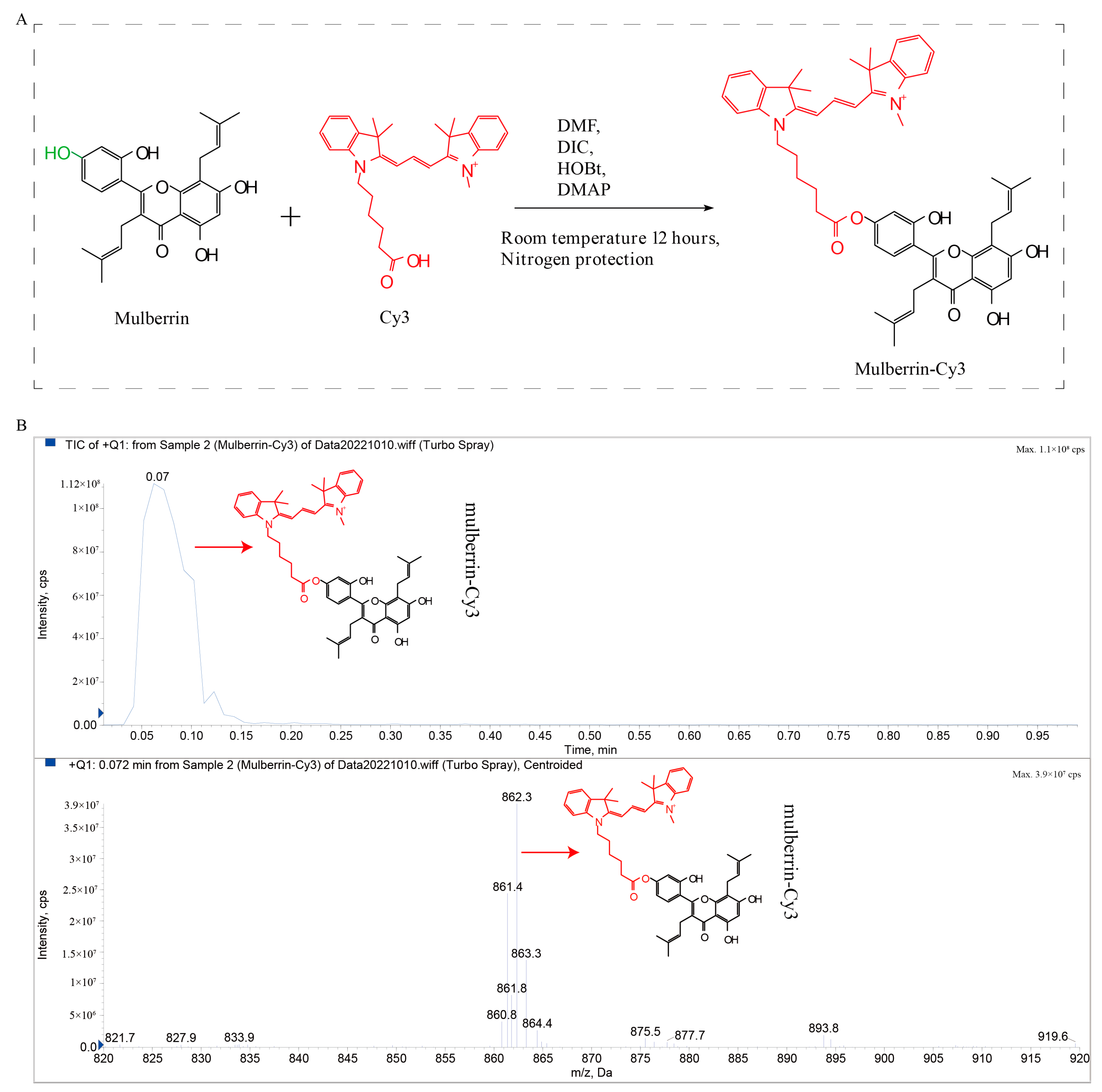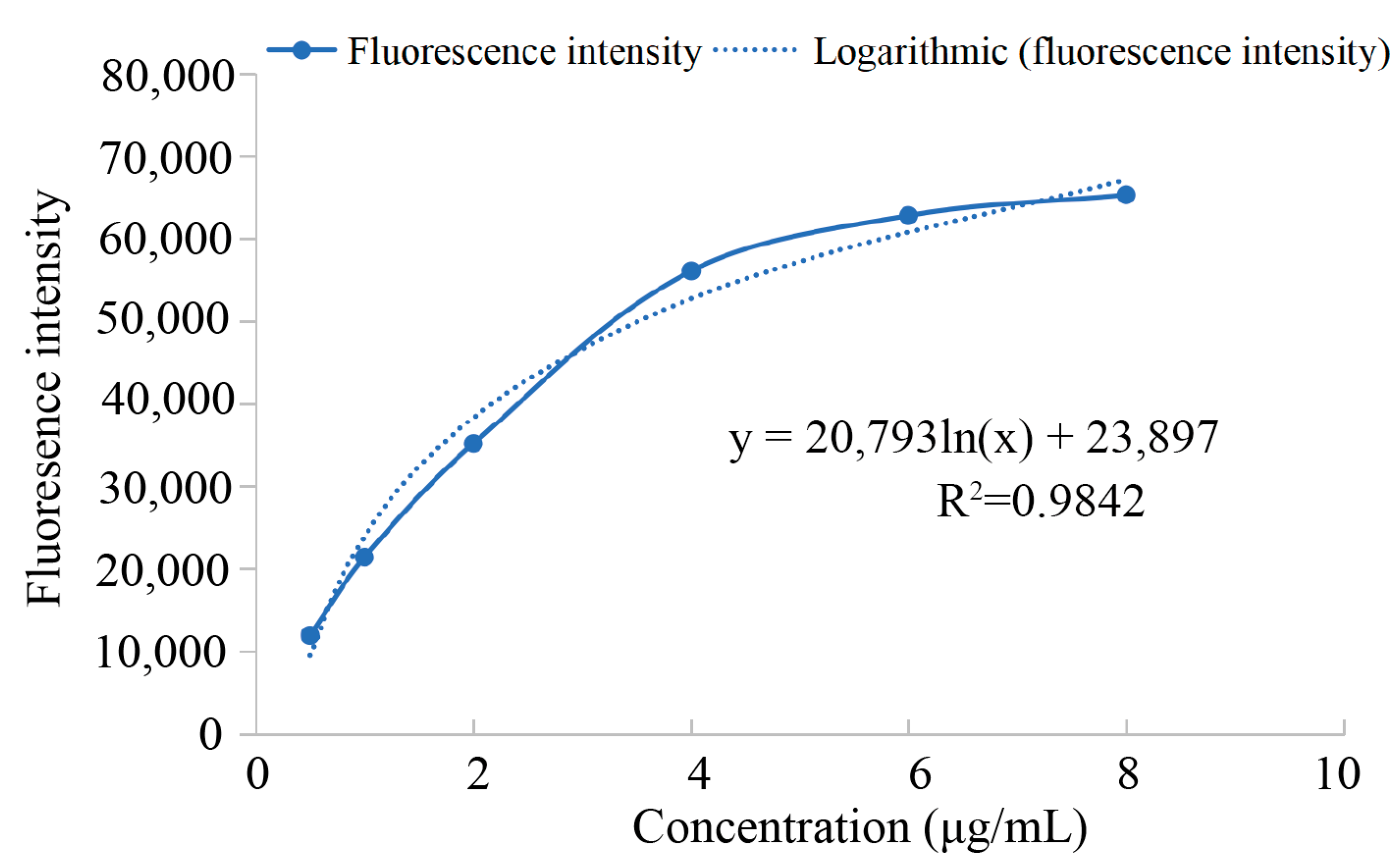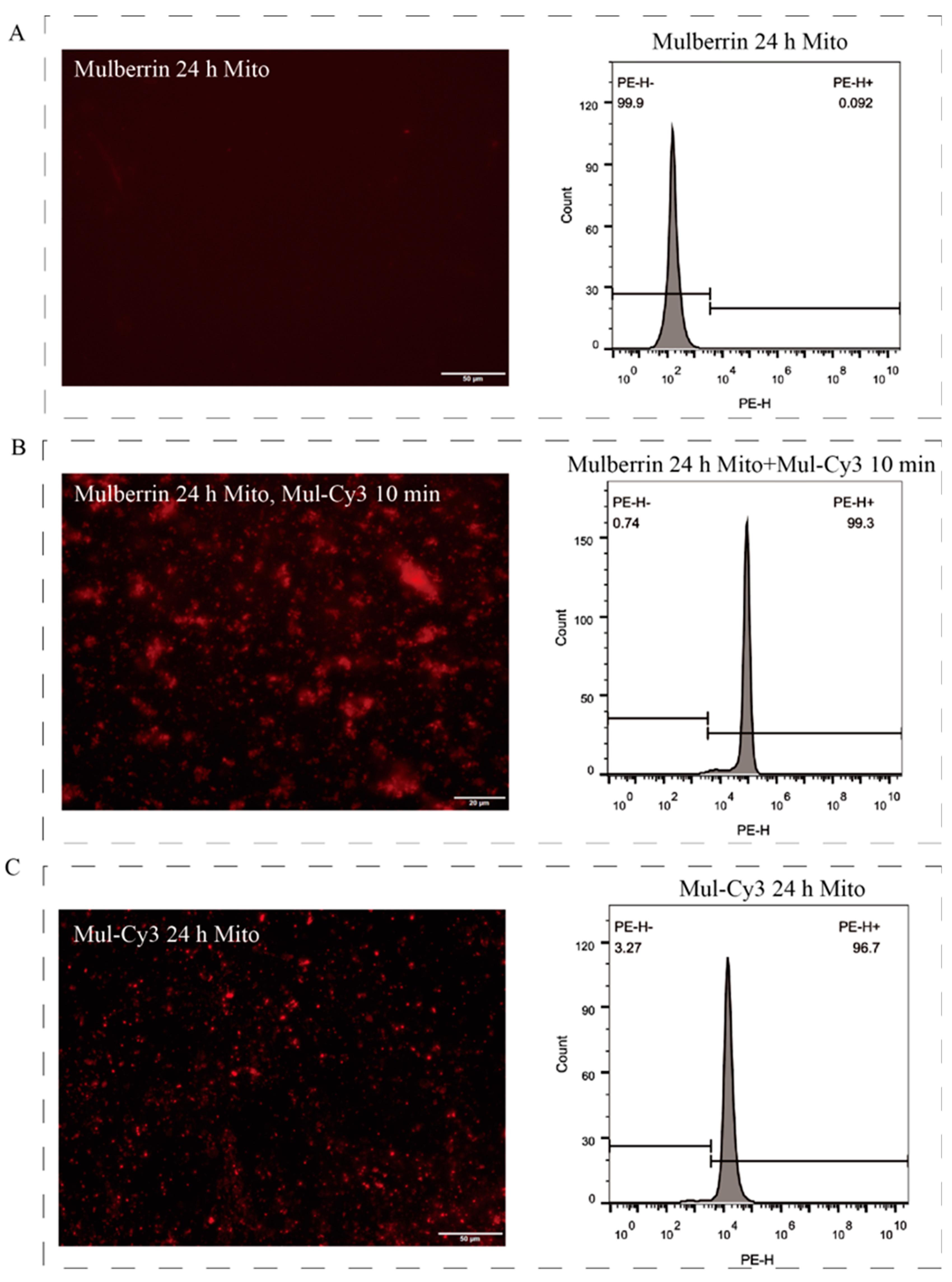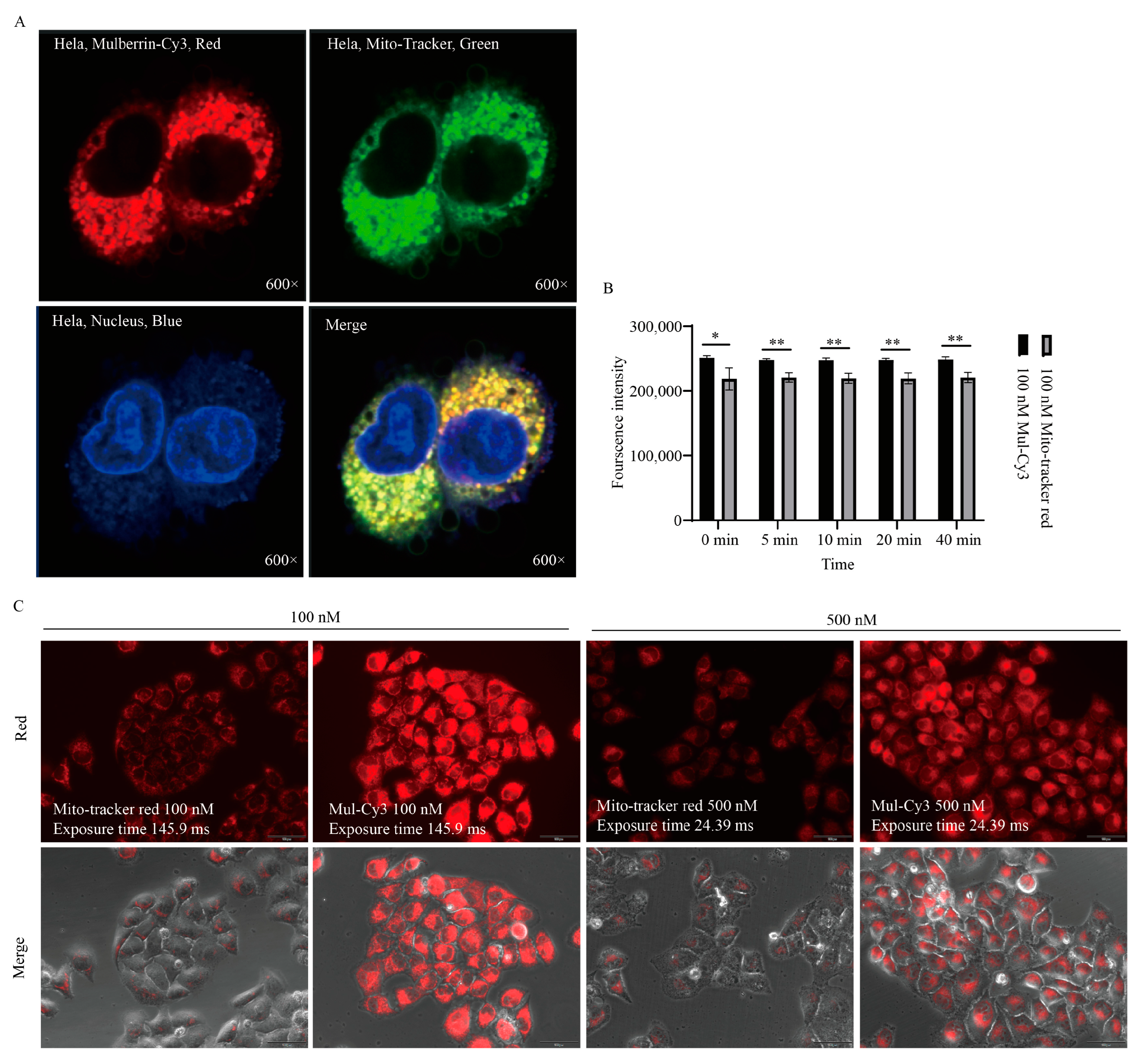Mitochondrial Labeling with Mulberrin-Cy3: A New Fluorescent Probe for Live Cell Visualization
Abstract
1. Introduction
2. Materials and Methods
2.1. Procedure
2.1.1. Synthesis of Mulberrin-Cy3
- (1).
- CY3-COOH with a weight of 10 mg was dissolved in 3 mL of DMF (N, N-dimethylformamide), and mulberrin (10.0 eq.), DIC (1,3-diisopropylcarbodiimide) (100.0 eq.), HOBt (1-hydroxybenzotriazole) (1.0 eq.), and DMAP (4-dimethylaminopyridine) (1.0 eq.) were added. This was dissolved completely.
- (2).
- The reaction was stirred under nitrogen protection for 12 h at room temperature and the solvent was removed by spinning under reduced pressure using the eluent dichloromethane/methanol (20:1) and purified by silica gel column chromatography.
- (3).
- Vacuum drying was performed to obtain the mulberrin-Cy3 product.
- (4).
- 3200 QTRAP® LC-MS/MS System was used for mass spectrometric analysis of mulberrin-Cy3.
- (5).
- RF-6000 Spectrofluorometer was utilized for the characterization of mulberrin-Cy3 fluorescence spectra (excitation wavelength, emission wavelength determination, and fluorescence intensity-concentration relationship analysis).
2.1.2. Preparation and Storage of the Mitochondrial Labeling Solution, Mulberrin-Cy3
- (1).
- Weigh 5 mg of mulberrin-Cy3.
- (2).
- Add 2.89 mL of anhydrous ethanol to dissolve mulberrin-Cy3.
- (3).
- Wait for complete dissolution and filter the solution with a 0.22 μM filter tip to remove bacteria, and finally obtain a final concentration of 2 mM mitochondrial labeling solution.
- (4).
- Store the filtered mitochondrial labeling solution in the refrigerator at −20 °C.
2.2. Animal (Cancer) Cell Mitochondrial Labeling
- (1).
- HeLa cell culture: HeLa cells should be cultured in Duchenne’s Modified Medium (DMEM) (Gibco, Cat. No. C111885500BT), which consists of 1 g/L D-glucose, L-glutamine, and 110 mg/L sodium pyruvate; add 10% fetal bovine serum (Sangon Biotech, Cat. No. E600001) and 1% penicillin/streptomycin (Gibco, Cat. No. 15140122) to the medium at 37 °C in an incubator (humidity 95% and 5% CO2). HeLa cells should be passaged to 12-well cell culture plates and confocal dishes for culture, and the subsequent staining steps can be started when the cell growth density reaches 80%.
- (2).
- Dilute the mitochondrial fluorescent marker master mix to a concentration of 10 μM and add it to the cultured adherent cells. Allow the mixture to incubate at room temperature for 5 min, followed by 3 washes with PBS, each lasting 2 min.
- (3).
- After washing, an appropriate volume of PBS should be added to the cell culture plate wells, and fluorescence microscopy imaging can then be conducted.
- (4).
- HeLa cells should be co-incubated with mulberrin-Cy3 (red fluorescence) and Mito-Tracker Green, with the nuclei subsequently stained using DAPI. After washing with PBS, the cells should be imaged using confocal microscopy.
- (5).
- The mulberrin-Cy3 mitochondrial fluorescent marker in the manner described above can also be used to label isolated mitochondria. In addition, during the staining process described above, mitochondria are usually labeled within 5 min of staining, or fluorescence microscopy and/or laser confocal microscopy can be performed immediately after the addition of the staining solution.
2.3. Cellular Mitochondrial Extraction
- (1).
- Transfer the treated HeLa cells to an ultra-clean bench, remove the medium from the cell culture flasks, wash the flasks twice with 2 mL of PBS solution, then add 1 mL of trypsin to the flasks to digest the cells, shake well so that the trypsin solution fully touches the cells, and then put them into a 37 °C cell culture incubator to digest for 90 s, and then add 2 mL of fresh medium to terminate the digestion, and then gently blow the cells with a 1 mL tip so that the cells are completely detached from the cell wall, and then transfer to a 5 mL centrifuge tube and put it into a centrifuge at 2000 rpm for 5 min. Remove the supernatant at the end of the centrifugation, add 1 mL PBS solution to wash the cells, then transfer to a 1.5 mL centrifuge tube and centrifuge at 2000 rpm for 5 min.
- (2).
- Collect the cells after centrifugation and then process the cell homogenization sample.
- (3).
- Cultured cell homogenization: 5 × 107 cells are needed for each extraction. Add 1 mL of ice pre-cooled Lysis Buffer to resuspend the cells, transfer the cell suspension into a small volume glass homogenizer, and grind 30~40 times in an ice bath.
- (4).
- Transfer the tissue or cell homogenate to a centrifuge tube and centrifuge at 1000× g for 5 min at 4 °C.
- (5).
- Remove the supernatant and transfer to a new centrifuge tube, then centrifuge again at 1000× g for 5 min at 4 °C.
- (6).
- Remove the supernatant and transfer to a new centrifuge tube and centrifuge at 12,000× g for 10 min at 4 °C. The supernatant contains cytoplasmic components from which cytoplasmic proteins can be extracted. Transfer the supernatant to a new centrifuge tube and deposit the mitochondria at the bottom of the tube.
- (7).
- Add 0.5 mL of Wash Buffer to the mitochondrial precipitate to resuspend the mitochondrial precipitate and centrifuge at 1000× g for 5 min at 4 °C.
- (8).
- Remove the supernatant, transfer to a new centrifuge tube, centrifuge at 12,000× g for 10 min at 4 °C. Discard the supernatant. The high-purity mitochondrial precipitate is at the bottom of the tube.
- (9).
- Resuspend the mitochondrial precipitate with 50–100 μL of Store Buffer or suitable reaction buffer and use immediately for subsequent experiments or store at −70 °C.
2.4. Mitochondrial Identification
- (1).
- A total of 2 μL of mitochondrial solution extracted from each treatment group was aspirated onto a slide, covered with a coverslip, and the mitochondrial morphology and fluorescence were observed and photographed using an inverted fluorescence microscope.
- (2).
- An amount of 10 μL of mitochondrial solution extracted from each treatment group was aspirated and added to 100 μL of PBS solution, mixed well, and then transferred to flow tubes for detection on a flow cytometer (URIT Flow Cytometer, BF-700, URIT Medical Electronic Co., Ltd., Guilin, China).
- (3).
- After isolating the mitochondria from mulberrin-treated cells, a portion of the mitochondrial solution was taken and added to mulberrin-Cy3 staining solution (10 μM) and incubated for 5~10 min, and then detected by fluorescence microscopy and flow cytometry (URIT Flow Cytometer, BF-700, URIT Medical Electronic Co., Ltd., Guilin, China).
- (4).
- We extracted mitochondria from mulberrin-Cy3-treated HeLa cells using a mitochondrial extraction kit (Solarbio, Cat No. SM0020, Beijing, China), then extracted mitochondrial proteins. To confirm the successful extraction of mitochondria, we incubated the mitochondrial proteins with a mitochondria-specific tagged protein antibody (COX4I1 antibody, BOSTER, Cat No. A05442-1, Wuhan, China, 1:1000 dilution) and performed Western blotting analysis (WB).
2.5. Comparison of Mulberrin-Cy3 with Commercially Available Mitochondrial Labeling Probes
- (1).
- The well-grown HeLa cells were passaged and cultured with confocal cell culture dishes.
- (2).
- When the cell growth density was about 80%, the cells were incubated with mulberrin-Cy3 and Mito-Tracker Green probes; meanwhile, the nuclei of the cells were stained by DAPI.
- (3).
- At the end of the incubation, mitochondrial labeling was photographed on a confocal microscope (Olympus Corporation, Tokyo, Japan). The results were then analyzed.
2.6. Determination of the Lowest Concentration of Mulberrin-Cy3 Labeling
3. Results
3.1. Synthesis Route of the Mitochondrial Red Fluorescent Labeling Compound Mulberrin-Cy3
3.2. Excitation Wavelength and Emission Wavelength of Mulberrin-Cy3
3.3. Mitochondrial Labeling of HeLa Cells
3.4. Comparison of Mulberrin-Cy3- and Mito-Tracker-Labeled Mitochondria
3.5. Mulberrin-Cy3 Labeling Concentration Measurement
4. Discussion
Advantages of Mulberrin-Cy3
- (1)
- Simple labeling process: do not pre-treat the cells, directly add mulberrin-Cy3 solution to cell culture plates/cell culture flasks (adherent cells) or cell suspension (suspended cells);
- (2)
- Fast labeling, stable red fluorescence, not easy to quench;
- (3)
- Short incubation time (5 min is enough), can be incubated at room temperature;
- (4)
- Stable after staining: it can be labeled with other stains without fear of fixation or permeabilization; it is not necessary to add an anti-fluorescence quencher to prevent fluorescence quenching before taking pictures of the microscope;
- (5)
- Lower cost: the price of developing into a commercial product is much lower than the mainstream products in the current market, which is helpful for reducing the cost of research and development;
- (6)
- The established mulberrin-Cy3 mitochondria staining solution is very stable and can be stored at 4 °C or −20 °C. Repeated freezing and thawing will not affect the mitochondrial labeling effect and it can be stored for a long period of time. Thus, it helps to simplify the sample preparation for cell analysis workflow;
- (7)
- Mulberrin-Cy3 is safe for the human body.
5. Conclusions
6. Patents
Supplementary Materials
Author Contributions
Funding
Institutional Review Board Statement
Informed Consent Statement
Data Availability Statement
Acknowledgments
Conflicts of Interest
References
- Green, D.E. Mitochondria—Structure, function, and replication. N. Engl. J. Med. 1983, 309, 182–183. [Google Scholar] [CrossRef] [PubMed]
- Pullman, M.E.; Schatz, G. Mitochondrial oxidations and energy coupling. Annu. Rev. Biochem. 1967, 36, 539–611. [Google Scholar] [CrossRef]
- Houten, S.M.; Violante, S.; Ventura, F.V.; Wanders, R.J. The Biochemistry and Physiology of Mitochondrial Fatty Acid β-Oxidation and Its Genetic Disorders. Annu. Rev. Physiol. 2016, 78, 23–44. [Google Scholar] [CrossRef] [PubMed]
- Long, J.Z.; Svensson, K.J.; Bateman, L.A.; Lin, H.; Kamenecka, T.; Lokurkar, I.A.; Lou, J.; Rao, R.R.; Chang, M.R.; Jedrychowski, M.P.; et al. The Secreted Enzyme PM20D1 Regulates Lipidated Amino Acid Uncouplers of Mitochondria. Cell 2016, 166, 424–435. [Google Scholar] [CrossRef] [PubMed]
- Verkerke, A.R.P.; Wang, D.; Yoshida, N.; Taxin, Z.H.; Shi, X.; Zheng, S.; Li, Y.; Auger, C.; Oikawa, S.; Yook, J.S.; et al. BCAA-nitrogen flux in brown fat controls metabolic health independent of thermogenesis. Cell 2024, 187, 2359–2374.e18. [Google Scholar] [CrossRef]
- Fang, W.; Jiang, L.; Zhu, Y.; Yang, S.; Qiu, H.; Cheng, J.; Liang, Q.; Tu, Z.C.; Ye, C. Methionine restriction constrains lipoylation and activates mitochondria for nitrogenic synthesis of amino acids. Nat. Commun. 2023, 14, 2504. [Google Scholar] [CrossRef]
- Haskins, N.; Bhuvanendran, S.; Anselmi, C.; Gams, A.; Kanholm, T.; Kocher, K.M.; LoTempio, J.; Krohmaly, K.I.; Sohai, D.; Stearrett, N.; et al. Mitochondrial Enzymes of the Urea Cycle Cluster at the Inner Mitochondrial Membrane. Front. Physiol. 2020, 11, 542950. [Google Scholar] [CrossRef]
- Zhou, Y.X.; Wei, J.; Deng, G.; Hu, A.; Sun, P.Y.; Zhao, X.; Song, B.L.; Luo, J. Delivery of low-density lipoprotein from endocytic carriers to mitochondria supports steroidogenesis. Nat. Cell Biol. 2023, 25, 937–949. [Google Scholar] [CrossRef] [PubMed]
- Nicholls, D.G.; Crompton, M. Mitochondrial calcium transport. FEBS Lett. 1980, 111, 261–268. [Google Scholar] [CrossRef]
- Boyman, L.; Karbowski, M.; Lederer, W.J. Regulation of Mitochondrial ATP Production: Ca(2+) Signaling and Quality Control. Trends Mol. Med. 2020, 26, 21–39. [Google Scholar] [CrossRef]
- Carneiro, B.A.; El-Deiry, W.S. Targeting apoptosis in cancer therapy. Nat. Rev. Clin. Oncol. 2020, 17, 395–417. [Google Scholar] [CrossRef] [PubMed]
- Willems, P.H.; Rossignol, R.; Dieteren, C.E.; Murphy, M.P.; Koopman, W.J. Redox Homeostasis and Mitochondrial Dynamics. Cell Metab. 2015, 22, 207–218. [Google Scholar] [CrossRef] [PubMed]
- Mishra, P.; Chan, D.C. Metabolic regulation of mitochondrial dynamics. J. Cell Biol. 2016, 212, 379–387. [Google Scholar] [CrossRef] [PubMed]
- Sekine, Y.; Houston, R.; Eckl, E.M.; Fessler, E.; Narendra, D.P.; Jae, L.T.; Sekine, S. A mitochondrial iron-responsive pathway regulated by DELE1. Mol. Cell 2023, 83, 2059–2076.e6. [Google Scholar] [CrossRef] [PubMed]
- Grotehans, N.; McGarry, L.; Nolte, H.; Xavier, V.; Kroker, M.; Narbona-Pérez, Á.J.; Deshwal, S.; Giavalisco, P.; Langer, T.; MacVicar, T. Ribonucleotide synthesis by NME6 fuels mitochondrial gene expression. EMBO J. 2023, 42, e113256. [Google Scholar] [CrossRef]
- Nunnari, J.; Suomalainen, A. Mitochondria: In sickness and in health. Cell 2012, 148, 1145–1159. [Google Scholar] [CrossRef]
- Marchi, S.; Guilbaud, E.; Tait, S.W.G.; Yamazaki, T.; Galluzzi, L. Mitochondrial control of inflammation. Nat. Rev. Immunol. 2023, 23, 159–173. [Google Scholar] [CrossRef]
- Bargiela, D.; Burr, S.P.; Chinnery, P.F. Mitochondria and Hypoxia: Metabolic Crosstalk in Cell-Fate Decisions. Trends Endocrinol. Metab. TEM 2018, 29, 249–259. [Google Scholar] [CrossRef]
- Floryk, D.; Houstĕk, J. Tetramethyl rhodamine methyl ester (TMRM) is suitable for cytofluorometric measurements of mitochondrial membrane potential in cells treated with digitonin. Biosci. Rep. 1999, 19, 27–34. [Google Scholar] [CrossRef]
- Crowley, L.C.; Christensen, M.E.; Waterhouse, N.J. Measuring Mitochondrial Transmembrane Potential by TMRE Staining. Cold Spring Harb. Protoc. 2016, 2016. [Google Scholar] [CrossRef]
- Garner, D.L.; Thomas, C.A.; Joerg, H.W.; DeJarnette, J.M.; Marshall, C.E. Fluorometric assessments of mitochondrial function and viability in cryopreserved bovine spermatozoa. Biol. Reprod. 1997, 57, 1401–1406. [Google Scholar] [CrossRef] [PubMed]
- Logan, D.C.; Leaver, C.J. Mitochondria-targeted GFP highlights the heterogeneity of mitochondrial shape, size and movement within living plant cells. J. Exp. Bot. 2000, 51, 865–871. [Google Scholar] [CrossRef]
- Ball, E.H.; Singer, S.J. Mitochondria are associated with microtubules and not with intermediate filaments in cultured fibroblasts. Proc. Natl. Acad. Sci. USA 1982, 79, 123–126. [Google Scholar] [CrossRef] [PubMed]
- Garner, D.L.; Thomas, C.A. Organelle-specific probe JC-1 identifies membrane potential differences in the mitochondrial function of bovine sperm. Mol. Reprod. Dev. 1999, 53, 222–229. [Google Scholar] [CrossRef]
- Gutscher, M.; Pauleau, A.L.; Marty, L.; Brach, T.; Wabnitz, G.H.; Samstag, Y.; Meyer, A.J.; Dick, T.P. Real-time imaging of the intracellular glutathione redox potential. Nat. Methods 2008, 5, 553–559. [Google Scholar] [CrossRef] [PubMed]
- Chazotte, B. Labeling mitochondria with MitoTracker dyes. Cold Spring Harb. Protoc. 2011, 2011, 990–992. [Google Scholar] [CrossRef] [PubMed]
- Haugland, R.P. Probes for Mitochondria. In Molecular Probes Handbook, A Guide to Fluorescent Probes and Labeling Technologies, 11th ed.; Life Technologies: Carlsbad, CA, USA, 2010; pp. 510–511. [Google Scholar]
- Patti, M.E.; Corvera, S. The role of mitochondria in the pathogenesis of type 2 diabetes. Endocr. Rev. 2010, 31, 364–395. [Google Scholar] [CrossRef]
- Lin, M.T.; Beal, M.F. Mitochondrial dysfunction and oxidative stress in neurodegenerative diseases. Nature 2006, 443, 787–795. [Google Scholar] [CrossRef]
- Dai, D.F.; Rabinovitch, P.S.; Ungvari, Z. Mitochondria and cardiovascular aging. Circ. Res. 2012, 110, 1109–1124. [Google Scholar] [CrossRef]
- Porporato, P.E.; Filigheddu, N.; Pedro, J.M.B.; Kroemer, G.; Galluzzi, L. Mitochondrial metabolism and cancer. Cell Res. 2018, 28, 265–280. [Google Scholar] [CrossRef]
- Beaulant, A.; Dia, M.; Pillot, B.; Chauvin, M.A.; Ji-Cao, J.; Durand, C.; Bendridi, N.; Chanon, S.; Vieille-Marchiset, A.; Da Silva, C.C.; et al. Endoplasmic reticulum-mitochondria miscommunication is an early and causal trigger of hepatic insulin resistance and steatosis. J. Hepatol. 2022, 77, 710–722. [Google Scholar] [CrossRef] [PubMed]
- Kanellopoulos, A.K.; Mariano, V.; Spinazzi, M.; Woo, Y.J.; McLean, C.; Pech, U.; Li, K.W.; Armstrong, J.D.; Giangrande, A.; Callaerts, P.; et al. Aralar Sequesters GABA into Hyperactive Mitochondria, Causing Social Behavior Deficits. Cell 2020, 180, 1178–1197.e20. [Google Scholar] [CrossRef]
- Javani, G.; Babri, S.; Farajdokht, F.; Ghaffari-Nasab, A.; Mohaddes, G. Mitochondrial transplantation improves anxiety- and depression-like behaviors in aged stress-exposed rats. Mech. Ageing Dev. 2022, 202, 111632. [Google Scholar] [CrossRef] [PubMed]
- Jain, R.; Begum, N.; Tryphena, K.P.; Singh, S.B.; Srivastava, S.; Rai, S.N.; Vamanu, E.; Khatri, D.K. Inter and intracellular mitochondrial transfer: Future of mitochondrial transplant therapy in Parkinson’s disease. Biomed. Pharmacother. Biomed. Pharmacother. 2023, 159, 114268. [Google Scholar] [CrossRef]
- Lin, R.Z.; Im, G.B.; Luo, A.C.; Zhu, Y.; Hong, X.; Neumeyer, J.; Tang, H.W.; Perrimon, N.; Melero-Martin, J.M. Mitochondrial transfer mediates endothelial cell engraftment through mitophagy. Nature 2024, 629, 660–668. [Google Scholar] [CrossRef] [PubMed]
- Chang, J.C.; Chang, H.S.; Wu, Y.C.; Cheng, W.L.; Lin, T.T.; Chang, H.J.; Kuo, S.J.; Chen, S.T.; Liu, C.S. Mitochondrial transplantation regulates antitumour activity, chemoresistance and mitochondrial dynamics in breast cancer. J. Exp. Clin. Cancer Res. CR 2019, 38, 30. [Google Scholar] [CrossRef]







| Concentration (μg/mL) | 0.5 | 1 | 2 | 4 | 6 | 8 |
|---|---|---|---|---|---|---|
| Fluorescence intensity | 11,944.766 | 21,375.713 | 35,119.884 | 56,129.718 | 62,816.1 | 65,311.047 |
Disclaimer/Publisher’s Note: The statements, opinions and data contained in all publications are solely those of the individual author(s) and contributor(s) and not of MDPI and/or the editor(s). MDPI and/or the editor(s) disclaim responsibility for any injury to people or property resulting from any ideas, methods, instructions or products referred to in the content. |
© 2024 by the authors. Licensee MDPI, Basel, Switzerland. This article is an open access article distributed under the terms and conditions of the Creative Commons Attribution (CC BY) license (https://creativecommons.org/licenses/by/4.0/).
Share and Cite
Yuan, G.; Luo, Y.; Qian, P.; He, N. Mitochondrial Labeling with Mulberrin-Cy3: A New Fluorescent Probe for Live Cell Visualization. Biosensors 2024, 14, 428. https://doi.org/10.3390/bios14090428
Yuan G, Luo Y, Qian P, He N. Mitochondrial Labeling with Mulberrin-Cy3: A New Fluorescent Probe for Live Cell Visualization. Biosensors. 2024; 14(9):428. https://doi.org/10.3390/bios14090428
Chicago/Turabian StyleYuan, Gangxiang, Yiwei Luo, Peng Qian, and Ningjia He. 2024. "Mitochondrial Labeling with Mulberrin-Cy3: A New Fluorescent Probe for Live Cell Visualization" Biosensors 14, no. 9: 428. https://doi.org/10.3390/bios14090428
APA StyleYuan, G., Luo, Y., Qian, P., & He, N. (2024). Mitochondrial Labeling with Mulberrin-Cy3: A New Fluorescent Probe for Live Cell Visualization. Biosensors, 14(9), 428. https://doi.org/10.3390/bios14090428






